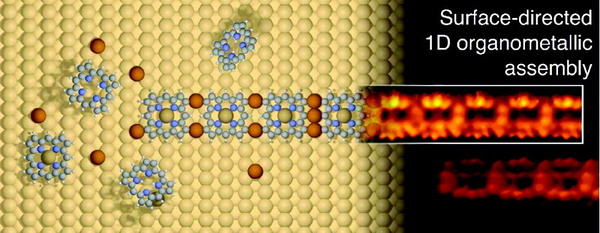
Journal of the American Chemical Society, 133 (2011) 12031–12039

The direct coupling of complex, functional organic molecules at a surface is one of the outstanding challenges in the road map to future molecular devices. Equally demanding is to meet this challenge without recourse to additional functionalization of the molecular building blocks and via clean surface reactions that leave no surface contamination. Here, we demonstrate the directional coupling of unfunctionalized porphyrin molecules–large aromatic multifunctional building blocks–on a single crystal copper surface, which generates highly oriented one-dimensional organometallic macromolecular nanostructures (wires) in a reaction which generates gaseous hydrogen as the only byproduct. In situ scanning tunneling microscopy and temperature programmed desorption, supported by theoretical modeling, reveal that the process is driven by C–H bond scission and the incorporation of copper atoms in between the organic components to form a very stable organocopper oligomer comprising organometallic edge-to-edge porphyrin–Cu–porphyrin connections on the surface that are unprecedented in solution chemistry. The hydrogen generated during the reaction leaves the surface and, therefore, produces no surface contamination. A remarkable feature of the wires is their stability at high temperatures (up to 670 K) and their preference for 1D growth along a prescribed crystallographic direction of the surface. The on-surface formation of directional organometallic wires that link highly functional porphyrin cores via direct C–Cu–C bonds in a single-step synthesis is a new development in surface-based molecular systems and provides a versatile approach to create functional organic nanostructures at surfaces.
The American Chemical Society holds the copyright for the published article. More information can be found on their website.
Limitted copies of the full text are available through the ACS Articles on Request service by following this link.
1Surface Science Research Centre and Department of Chemistry, University of Liverpool, Liverpool, UK
2Department of Applied Physics, Chalmers University of Technology, SE-412 96, Göteborg, Sweden
3Institut de Ciència de Materials de Barcelona (ICMAB–CSIC), Campus Universitari, 08193-Bellaterra, Catalonia, Spain